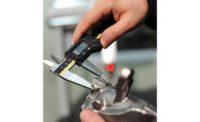
On the Go
Companies such as Electro-General Corp. realized that portability was becoming an important requirement of data collection systems, and in the late 1970s developed microprocessor-based collectors that could be carried around the shop floor. These new devices untethered data collection and were an instant hit. These products were so successful that they overshadowed the company that made them. In 1983, Electro-General changed its company name to the name of the ubiquitous product, the DataMyte.Portability, however, came at a price. The collectors were no longer connected to a central data repository. Because of this, quality personnel were burdened with keeping the central repository updated with the latest collected data. This often meant walking the portable collector to a central computer and unloading the data so that it could be integrated with similar data from all parts of the factory. This manual unloading of data was unproductive at best, and in many cases resulted in loss of data that was never uploaded, or in the delayed integration of data long after its usefulness had expired.
Because of the relative infancy of this technology, these collectors also were plagued with low-resolution monochrome displays that showed only a minimum amount of information. Another problem with these early portables was the use of proprietary hardware and operating software. This made enhancement of the capabilities costly and time-consuming. As the market matured, and many more players became involved, the portables evolved by incorporating larger displays and enhanced feature sets, but like their ancestors, these next-generation units used proprietary hardware and software and did not easily share data with a central computer.
By 1990 a glaring flaw in the portable market was this inability to share data with other computers or "network." Manufacturers wanted the portability but they also needed to upload data to a central repository for analysis in a more timely fashion. This caused the portable vendors to create distributed "collection stations" throughout the factory. These stations consisted of a CRT display for units without a larger display and a hard wire that the collector could plug into. This allowed subgroups to once again be uploaded to a central repository automatically on collection when connected to the station. Unfortunately, this trend also grounded the portables; they were now tethered to a wire.
By 1995, operators were getting used to computers on their desktop, and the factory floor was becoming wired with Local Area Network infrastructure. This caused a further shift to fixed-station collectors. Because the portables were tied down anyway, why not revert to collection terminals throughout the factory? After all, these Windows-based collection stations were low cost, easily networked, had full-color displays, and used standard operating systems making development and customization easier and less costly.
Had the need for portability that was addressed in the 1980s gone away? Each manufacturer can answer that question for himself and his operations. If they did not implement or abandon portable data collection because of the networkability issues, or because they could get more success with a Windows PC on the shop floor, it may be time to take another look.

Another Look
New technology has untethered the portable collector. Wireless networking is a standard capability on the latest generation of handheld computing devices. Data can be uploaded in real time to a central repository without a wire using standard WiFi technologies.
By using these technologies, longevity can be added to capital investment. For example, consider devices that can be easily upgraded by installing new software, or that can be shared for additional applications on the shop floor. One of these new handheld computers can run not only shop floor data collection applications, but also can run familiar standard software such as a browser to access the corporate intranet to retrieve work instructions, drawings or operating procedures.
Imagine the power of a handheld device if the same device used in quality control operations also allows bar code scanning for use in factory floor data collection, inventory tracking and other day-to-day operations. The wireless capability provides a real-time view into all the operations taking place on the shop floor at any time.
This device also can act as a dumb terminal, running the WaveLink terminal emulation client. So now the portable device can truly replace the fixed station device and communicate directly to the host computer. With Windows CE .NET, multiple applications can run simultaneously, communicate with the mini or mainframe, run a new browser application and instantly switch between them.
These devices also can be used for employees involved in a variety of field operations, from field service to route accounting, even multistop delivery applications. Using Windows-based mobile computers with specific field operations software, field service inspectors can perform data entry, improve field service management and support customers in real-time.
With economics placing an increasing demand on cost justification, the stage has been set for devices serving a sundry of data collection applications simultaneously. There are a myriad of handheld PCs that can collect barcode data for production and materials management applications, but the challenge of collecting data with the same device in areas such as quality control has been less successfully satisfied by PC manufacturers. The obstacle of interfacing the digital, serial and analog measurement gages, required to ensure compliance to manufacturer's specifications, is a challenge. With the demands placed on the IT staff for compliance and uniformity, the goal of collecting data from the same handheld PC, regardless of the department, would be an accomplishment indeed.
One-stop shopping adds convenience by lessening operator training time, increasing flexibility of operator repositioning, allowing for borrowed of units in emergencies, providing for a single contact when service or support is needed and aiding in cost justification. Q
Tech Tips
• New technology has untethered the portable collector.
• Wireless networking is a standard capability on the latest generation of handheld computing devices.
• Data can be uploaded in real time to a central repository using standard WiFi technologies.
